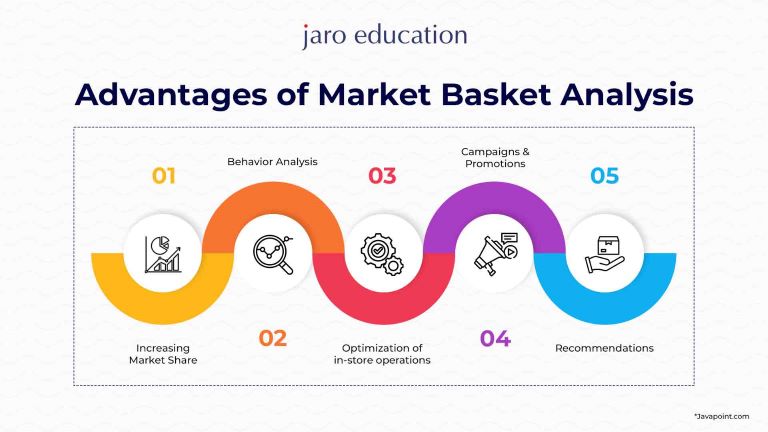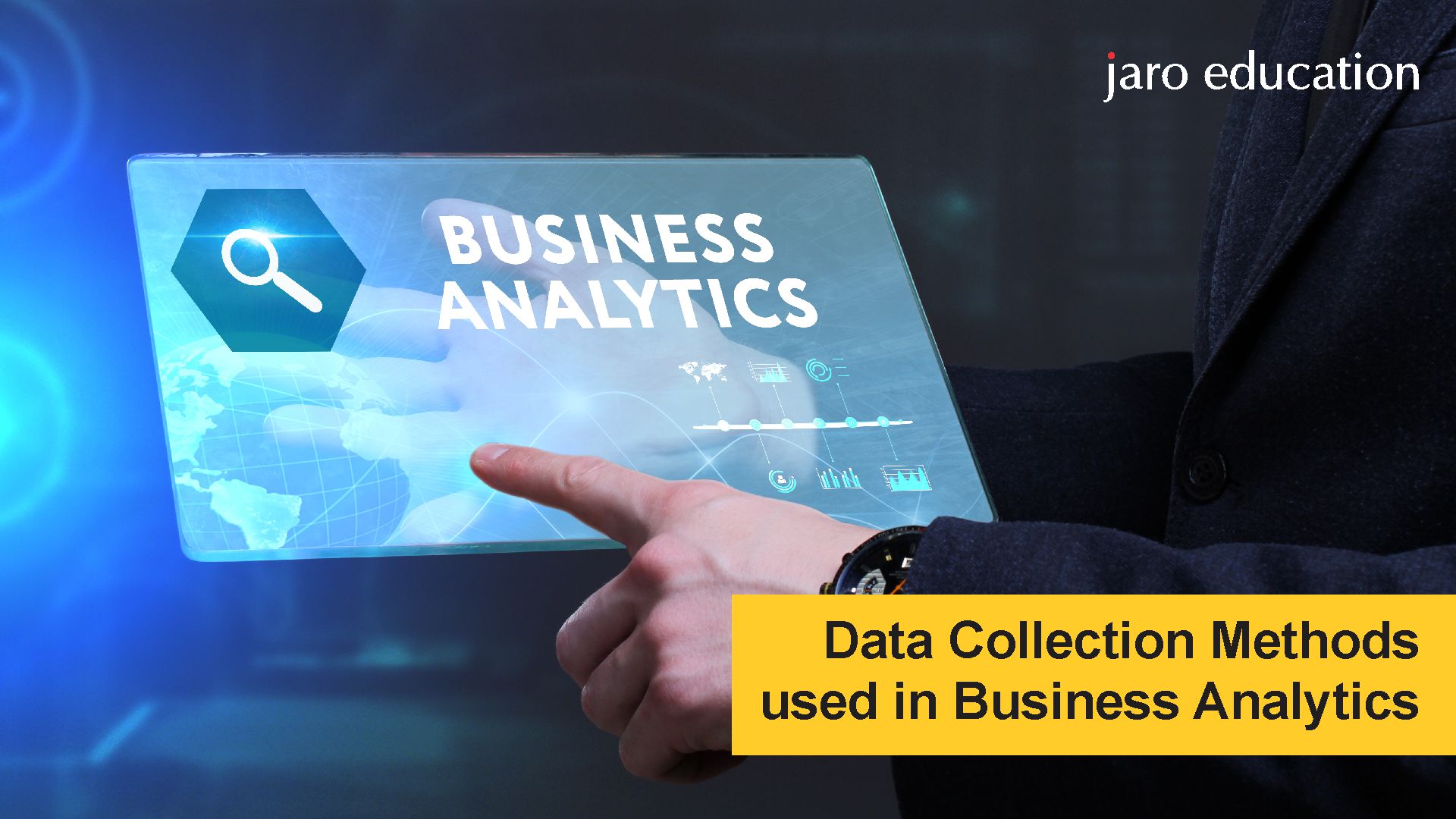Understanding Market Basket Analysis in Data Mining
Table of Contents

- jaro education
- 9, September 2023
- 4:00 pm
Market basket analysis is a technique in data mining that is used to find buying trends in any retail context. This method provides a thorough study of customers’ purchases in a supermarket and analyzes the pattern of frequently purchased goods by consumers. This study can help organizations to promote offers, deals, and sales. The data mining tools further help organizations to conduct work in an effective way. In simple words, market basket analysis in data mining examines the mix of items purchased together.
To increase production and sales of goods, market basket analysis is crucial. It is a part of data science that analyzes what the company is doing and what it can achieve. Data science for business decisions can make the process of growth simpler. Many young aspiring managers, senior executives and team leaders are pursuing professional data science courses to hone their skills in the business market.
If you also want to be a senior executive of a company, take a Professional Certificate Programme in Data Science for Business Decisions from IIM Kozhikode. This course offers an interactive learning approach and a comprehensive curriculum on data science. The programme enables students to develop critical and analytical thinking abilities, practical insights with real-life case studies, and apply learnings with capstone projects and world-class learning experiences with top-notch faculty. Register with Jaro Education to get an overall idea about the program.
Understanding Market Basket Analysis in Data Mining
Market basket analysis is a type of data analytics tool that identifies the goods or items that people purchase together. To identify customers’ buying behavior and analyze the popular product combinations, this research is conducted in the retail industry. The results of a market basket analysis may be used for various purposes, such as generating targeted marketing campaigns, improving product placement in stores, and enhancing inventory control. This analysis includes collective information about client transactions and then using rule learning algorithms to the data to detect records.
Market basket analysis is a beneficial tool for retailers because it allows them to identify the connections between various commodities and discover opportunities to increase sales and improve consumer satisfaction. Retailers may make better-informed decisions regarding product pricing, promotions, and placements by understanding what items are frequently purchased together. This can lead to enhanced revenue and increased consumer loyalty.
Types of Market Basket Analysis
There are two categories of market basket analysis.
1. Differential Market Basket Analysis
Differential Market Basket Analysis, or DMBA, is a statistical method that determines the difference between two or more market baskets, or sets of commodities, that customers frequently purchase together. This method is used widely in the marketing and retail sectors to analyze customer purchasing behavior and to find trends and patterns in sales data. DMBA aims to identify goods unique to each market basket and the relationships between them, which may subsequently be utilized to influence product placement, promotional strategies, and other marketing decisions.
2. Predictive Market Basket Analysis
In data mining, predictive analysis is an approach that analyzes previous consumer purchase data to forecast future customer behavior. This analysis seeks to discover things that are likely to be purchased together and then utilize this knowledge to drive marketing tactics, inventory management, and business choices such as product placement. Statistical and machine learning techniques, like sequence analysis and association rules, are frequently used in this sort of study to analyze the associations between elements. The model is trained on previous data and may be used to forecast future purchases, such as recommending goods that a consumer is likely to purchase in the future or detecting products that are likely to be out of stock.
Thus, predictive market basket analysis is a useful technique for retailers and other organizations looking to better understand their consumers and enhance their operations.

Uses of Market Basket Analysis
In various sectors, market basket analysis is applied. The most common ones are:
Retail Market
Retailers using market basket research can find goods that are frequently purchased together by customers. This analysis can help in product marketing, pricing choices and product placement, thereby leading to more income and improved client satisfaction.
Telecommunications
To study consumer data and detect trends, telecommunication companies utilize market basket analysis. This data can be used to boost revenue and enhance customer experience.
Healthcare
Organizations in the healthcare sector apply market basket analysis to analyze patient data and identify co-occurring diseases or treatments. This information might be used to improve patient outcomes while simultaneously cutting healthcare costs.
Financial Banking and Services
Banks and financial entities use market basket analysis to investigate client data and reveal trends in their buying habits. This information may be used to increase consumer loyalty and develop tailored marketing campaigns.
E-commerce
Online retailers may use market basket analysis to assess client purchase data and identify which commodities are frequently purchased together. This information may be used to create targeted product bundles and for upselling as well.
How does Market Basket Analysis Work?
To understand how market basket analysis works, aspiring candidates first need to know the algorithms used in this strategy. Market basket analysis in data mining is based on the association rule that includes Apriori, AIS, and SETM algorithms. The Apriori is the MBA algorithm that is mostly used in this technique of data mining.
In the association rule, the IF, THEN construct is utilized to duplicate the market basket analysis. For instance, if a customer buys bread, likely, he would also purchase butter. An example of association rules is “Bread” -> “Butter”.
To understand how exactly it works, professionals should know the definitions of antecedent and consequent.
Antecedents are the entities or “itemsets” created from the data. In other words, it’s the IF element on the left. Bread is the antecedent in the preceding circumstance.
The term “consequent” implies an item or set of objects encountered after the antecedent. The THEN portion of the statement is seen on the right. For instance, in the above example, the end product is butter.
What are the Metrics Used for Market Basket Analysis?
Professionals can include various unique controls on their association rules. These consist of support, confidence and lift.
For instance, say a popular e-commerce website handled 5000 transactions. Now, they want to determine the support, confidence and lift for the two products: phone and phone cover. Out of 5000 transactions, let’s say 700 transactions were for phone covers, 500 for phones and 1000 for both.
To calculate SUPPORT, professionals require the number of transactions divided by the total sum of the transaction made.
Support = freq(A, B)/N
support(phone) = transactions related to phone/total transactions
i.e support -> 500/5000=10 per cent
For CONFIDENCE, it is determined if the product sales are popular on an individual or combined basis. Using combined/individual transactions, this metric is calculated.
Confidence = freq(A, B)/freq(A)
Confidence = combine transactions/individual transactions
i.e. confidence-> 1000/500=20 per cent
To determine the sales ratio, LIFT is calculated
Lift = confidence/support percentage
Lift-> 20/10=2
If the value of LIFT is <1, it means the products are not purchased by customers frequently. However, in this scenario, it can be seen that the probability of purchasing both things combined is high in comparison with the transactions of each item sold.
Advantages of Market Basket Analysis in Data Mining
Market basket analysis has several advantages, including:
Improved customer understanding
Market basket research exposes customer behavior and purchasing trends, helping businesses to understand their customers’ needs better.
Improved sales
By studying which products are frequently purchased together, businesses can elevate their sales and enhance customer satisfaction.
Increased inventory management
Market basket analysis may help businesses improve their inventory management by indicating which items are often bought together and which products are not selling well.
Better customer experience
Businesses may enhance the customer experience by better understanding client behavior and purchasing habits, such as making things more accessible or giving special offers.
Final Thoughts
To get information regarding hidden linkages and associations, there has been an increase in the use of market basket analysis by several companies. To examine the capability of this technique, differential and predictive methods are gaining momentum across numerous industries in an effort to pinpoint consecutive purchases.
If you’re interested in pursuing a career in data mining and data science, apply for the 1 year Professional Certificate Programme in Data Science for Business Decisions at IIM Kozhikode. This course allows candidates to gain analytical and critical thinking abilities, attend interactive lectures and participate in group discussions.











